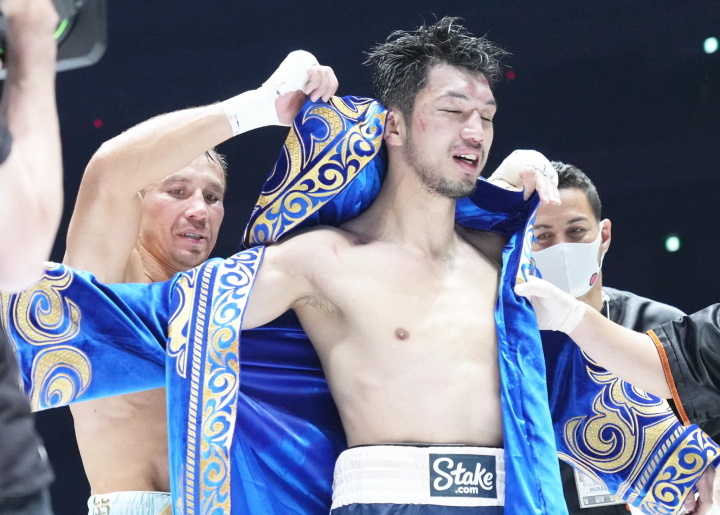While the boxing public was asking questions about what Gennadiy Golovkin had left, his upcoming opponent Ryota Murata was asking questions about himself. (photo by Naoki Fukuda)
In his two years and four months out of the ring, a good portion of it dedicated to hoping then waiting for a bout with Golovkin, Murata had a lot of time to experience doubt. He read the dark novels of Fyodor Dostoevsky and The Mustard Seed by Osho. The week of the bout, he told reporters that while he felt a tinge of nervousness, he was most concerned about catching COVID-19 and causing another postponement of the bout. In his Tokyo hotel room, he stayed away from his family, from everyone, overlooking the city scape he would visit on school trips as a child, never fathoming that most of the people below would one day know who he was.
Murata revealed to Toshio Ninomiya of Number magazine that he had been working with Dr. Miyako Tanaka, a sports psychologist, certified mental training instructor and 1988 Olympian in synchronized swimming. In his sessions with Tanaka, Murata says that he wrote his doubts and negative feelings on a white board, so that he could truly confront himself. During his layoff, his fitness wavered nominally as it would be expected to during down periods, but he also wound up in a “negative loop” at times, questioning his own abilities, battling periods of depression. He said that Tanaka helped him realize that his negative feelings were normal, to contextualize them and be able to focus on the biggest fight of his life.
The biggest boxing star in all of Japan, he finally had his dream matchup against Golovkin, the biggest boxing match of a generation in his country, possibly since the Japanese megafight between Koki Kameda and Daisuke Naito.
On Saturday in Saitama, Murata confronted everything head-on. He walked to the ring to the Pirates of the Caribbean theme as he has many times, shuffled to the center of the ring and met Golovkin glove to glove, forehead to forehead as soon as the bell sounded. For a good portion of five rounds, everything was going as he’d always dreamt it would. Murata wagered that his best chance of winning was to make Golovkin’s 40-year-and-one-day old body work as hard as possible. Force GGG to push him away, force his legs to move a little more than they want to.
During that time period, some combination of Golovkin’s inactivity, age and Murata’s presence had him looking uncomfortable. There were times when it appeared as though Golovkin was overcompensating to defend against Murata’s hard body shots. When he did that, Murata hit him upstairs with straight right hands, an adaptation made to his technique after years of favoring right hands that landed around his opponents’ guard rather than between it. Murata was big, physical, accurate, and confident. As Hall of Fame promoter Mr. Akihiko Honda told him to do prior to the bout, he was having fun, smiling as he walked back to his corner each round, even as the blood was flowing and the accumulating damage was beginning to become present on his face.
A minute into the sixth round however, the momentum of the fight swung completely. Golovkin’s moments had been getting more and more frequent, but he was always met with resistance from Murata until this moment. Golovkin landed a trademark stiff jab and brought a right cross immediately behind it. The force he threw it with was aided by the fact that Murata was leaning forward trying to push Golovkin back. The shot sent Murata’s mouthpiece flying across the ring. Referee Luis Pabon halted the action to get Murata his equipment back, but it would be less than three rounds before he was waving the fight off entirely.
In that moment, Murata lost his ability to pressure Golovkin back, and the strength to hit him with meaningful shots, though certainly not the courage to try. But with courage alone is a perilous way to approach GGG, who began putting his punches together the way he had at his physical peak. Firm jabs, hooks to the body, uppercuts on the inside and his patented downward arc left hook, all of them were now connecting, sometimes in succession.
Golovkin’s legs might not have looked the way they once did, but his hands and his power still did. In fact, with his feet planted more often and the action taking place at close proximity, Golovkin was at times forced to throw faster and harder than he otherwise would to compensate. In the ninth round, he found a similar right hand to the one that had turned the fight irreversibly. Murata’s legs buckled and his inadvertently turned around, looking lost before finding the canvas. He wasn’t willing to give up his dream, but his corner knew it was best that he did. As the white towel hit the canvas, tears filled the eyes of some of the fans at ringside.
After the fight, Murata went back to his hotel room and slept for four hours. He told reporters he’d abstained from drinking coffee during training camp, but when he tried to drink one upon waking up, he said his jaw was in too much pain and the hot liquid stung his mouth. His neck, his shoulders and his chin were in pain, but his spirit was never broken in the ring.
Murata wouldn’t comment on his fighting future, but seemingly made allusions to it potentially being his last fight. And understandably so. After emptying everything emotionally and physically into one fight and coming up far short, how can you imagine doing it again?
“I will have to think after a long rest,” said Murata. “I’m still in the acceptance stage.”
Corey Erdman is a boxing writer and commentator based in Toronto, ON, Canada. Follow him on Twitter @corey_erdman.
